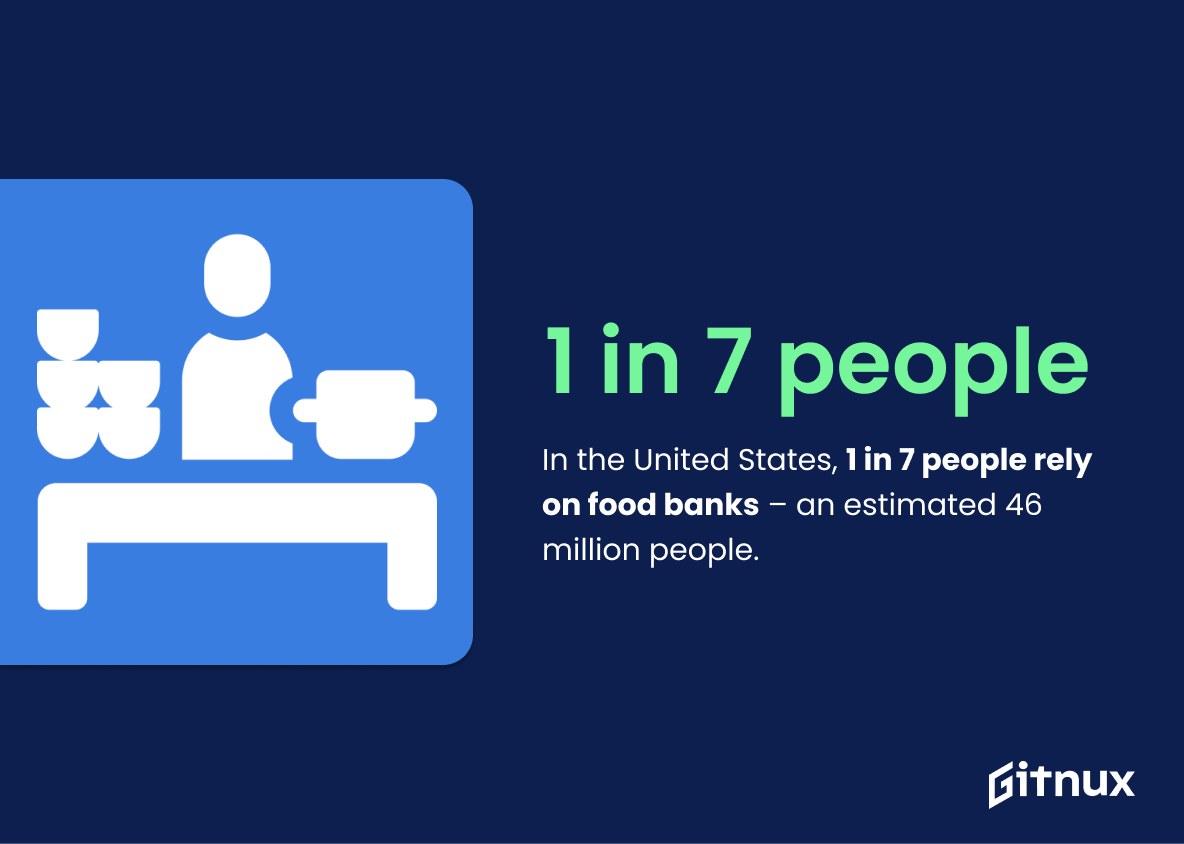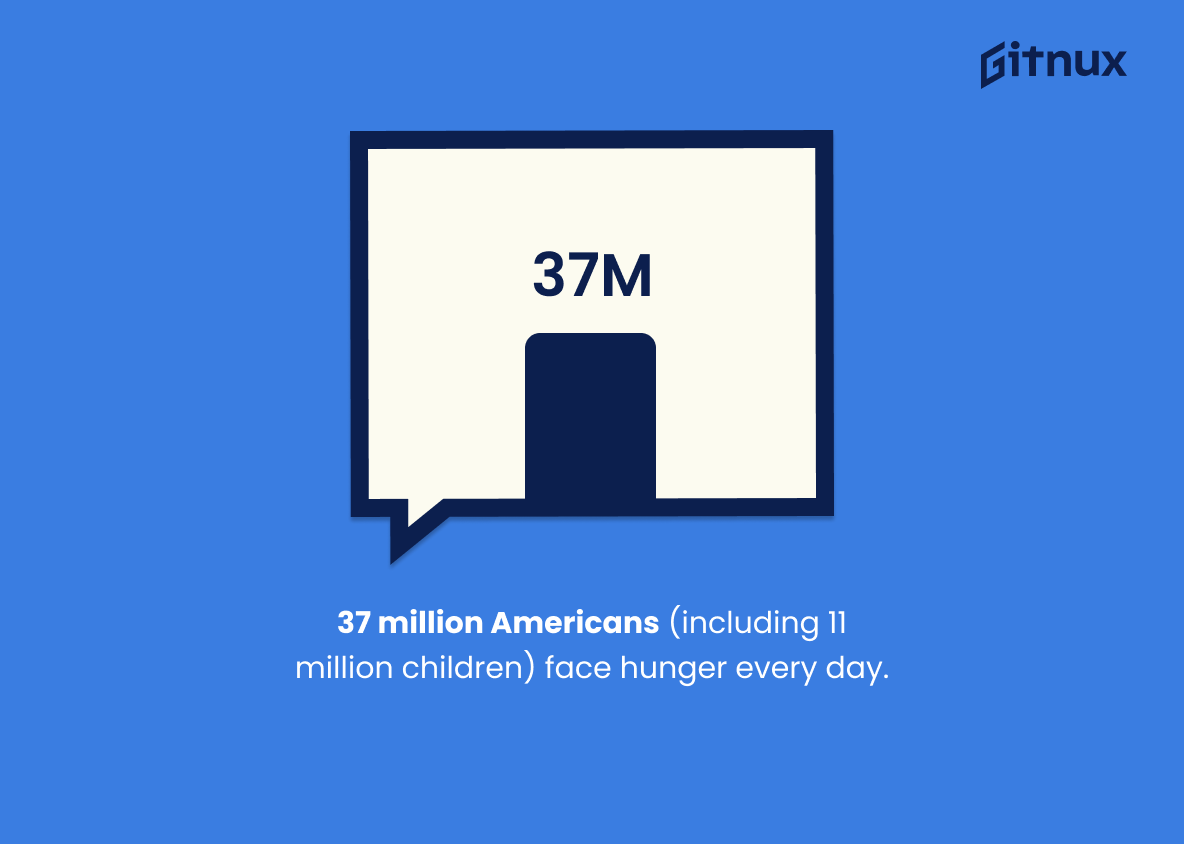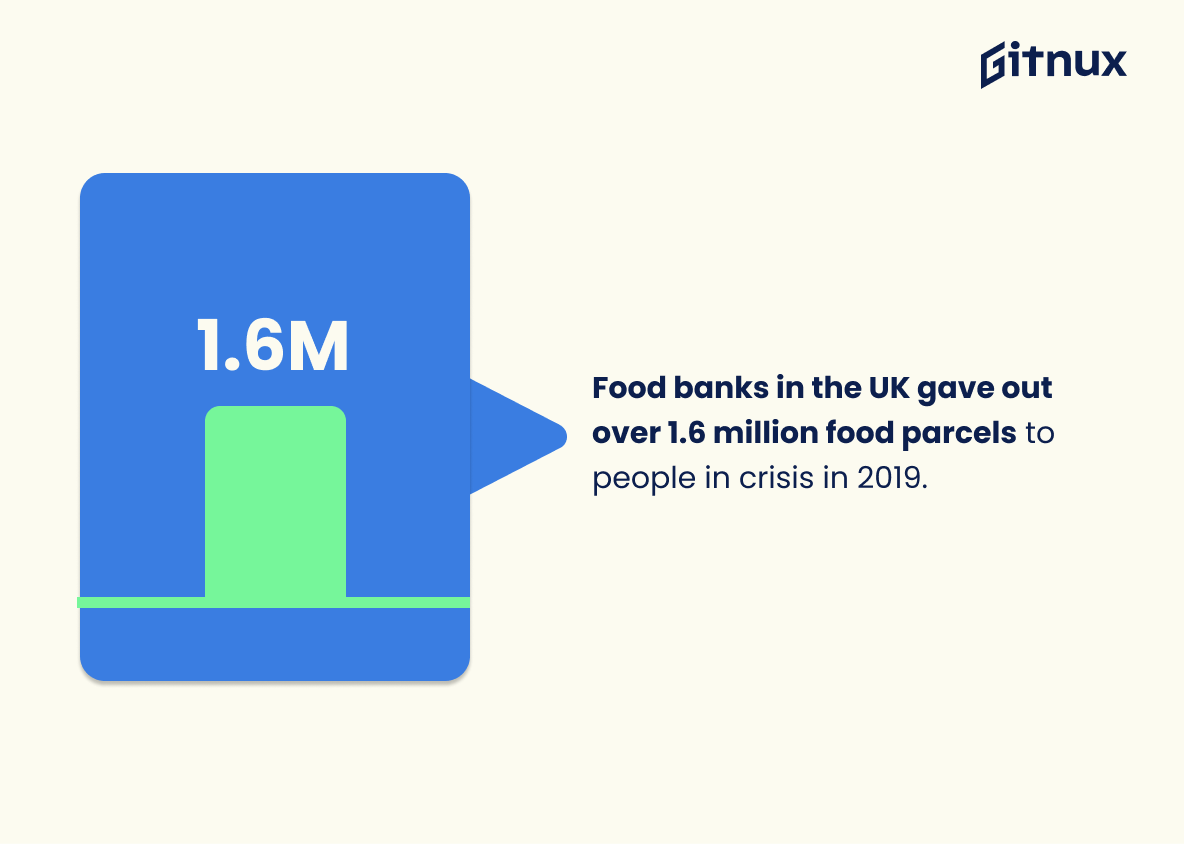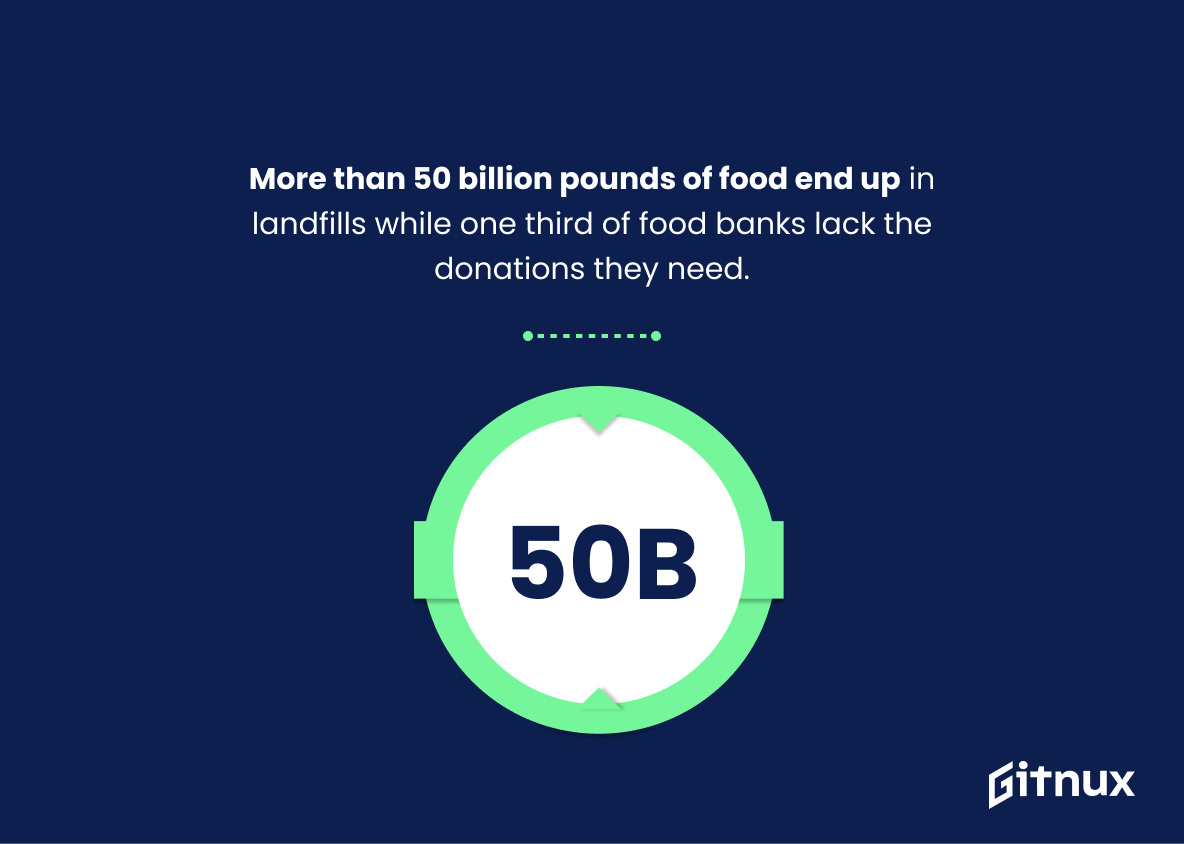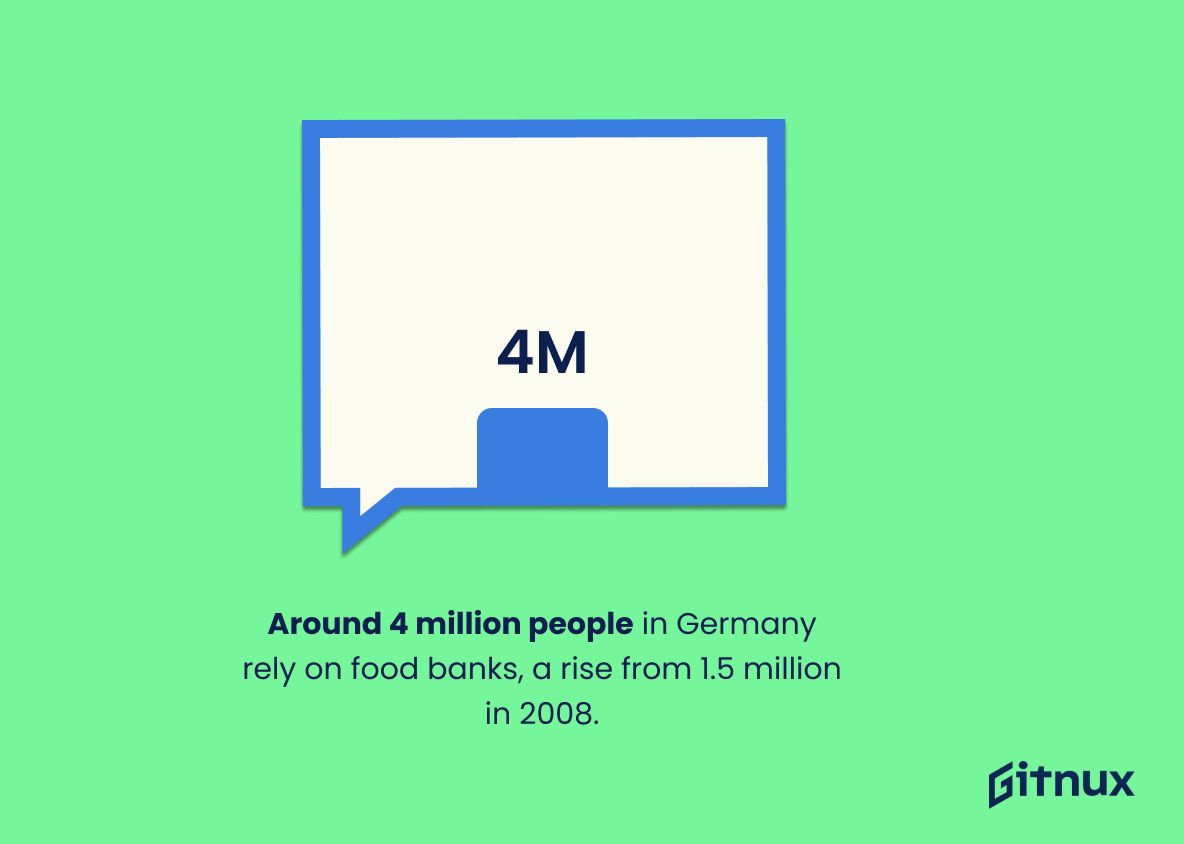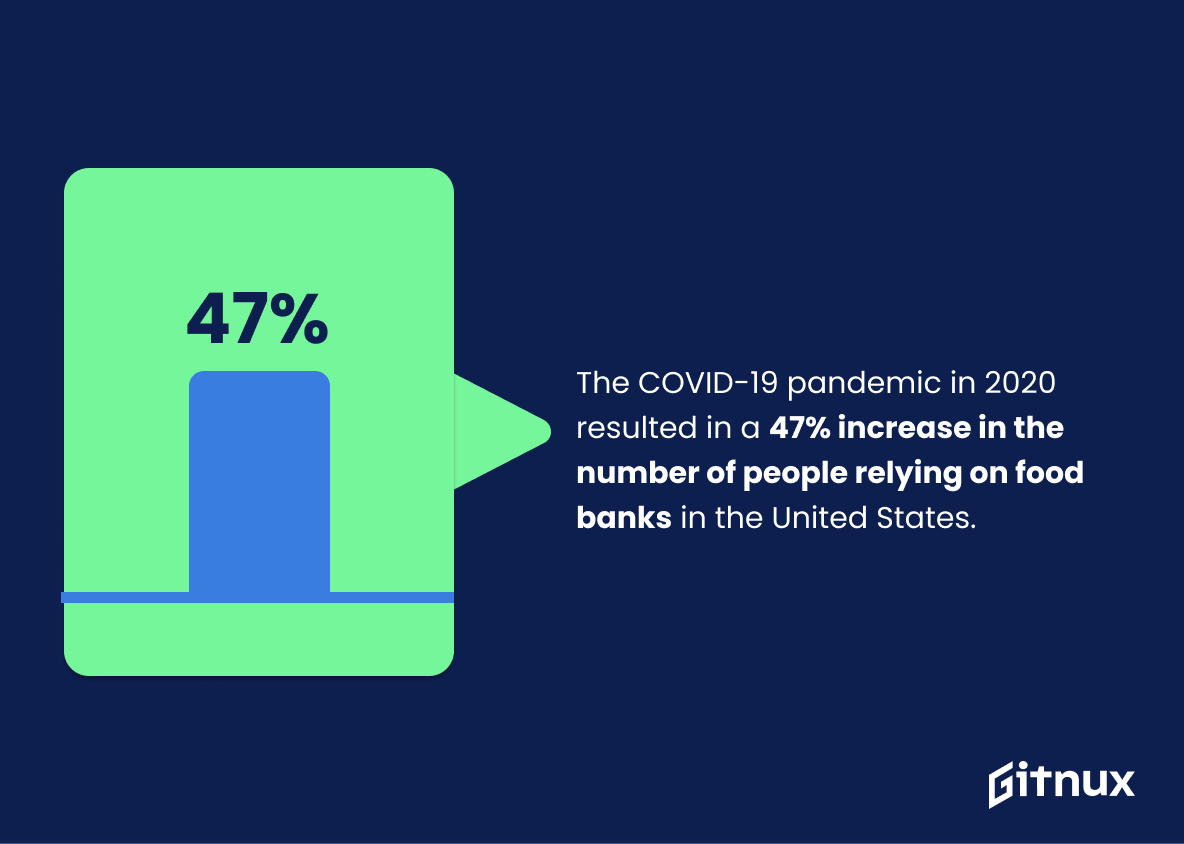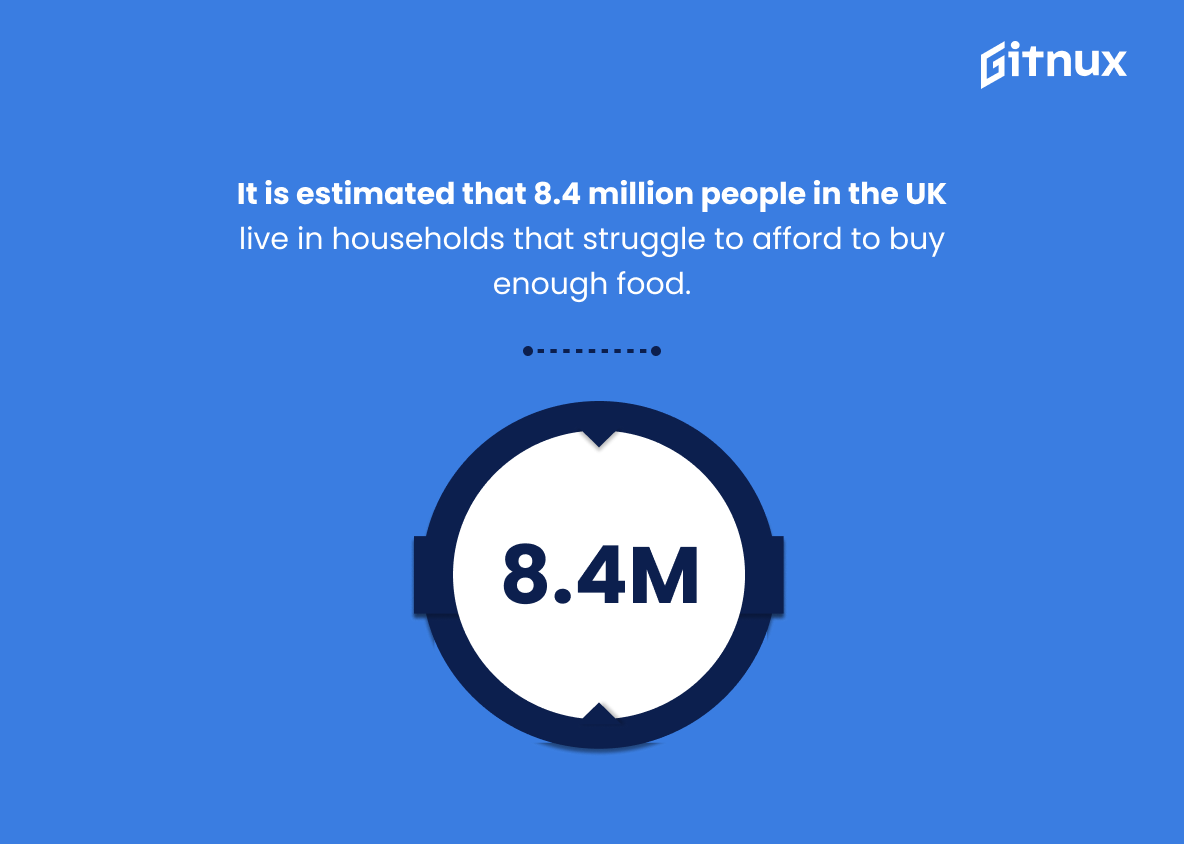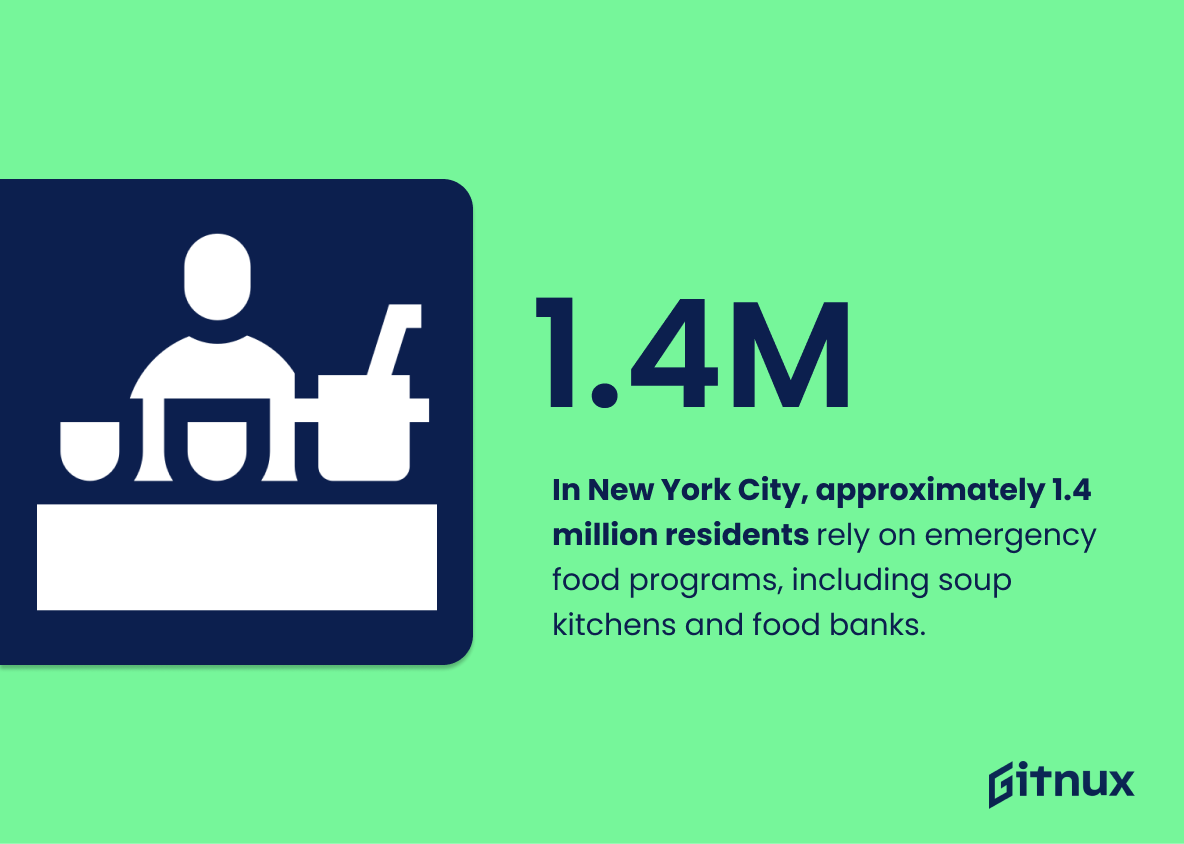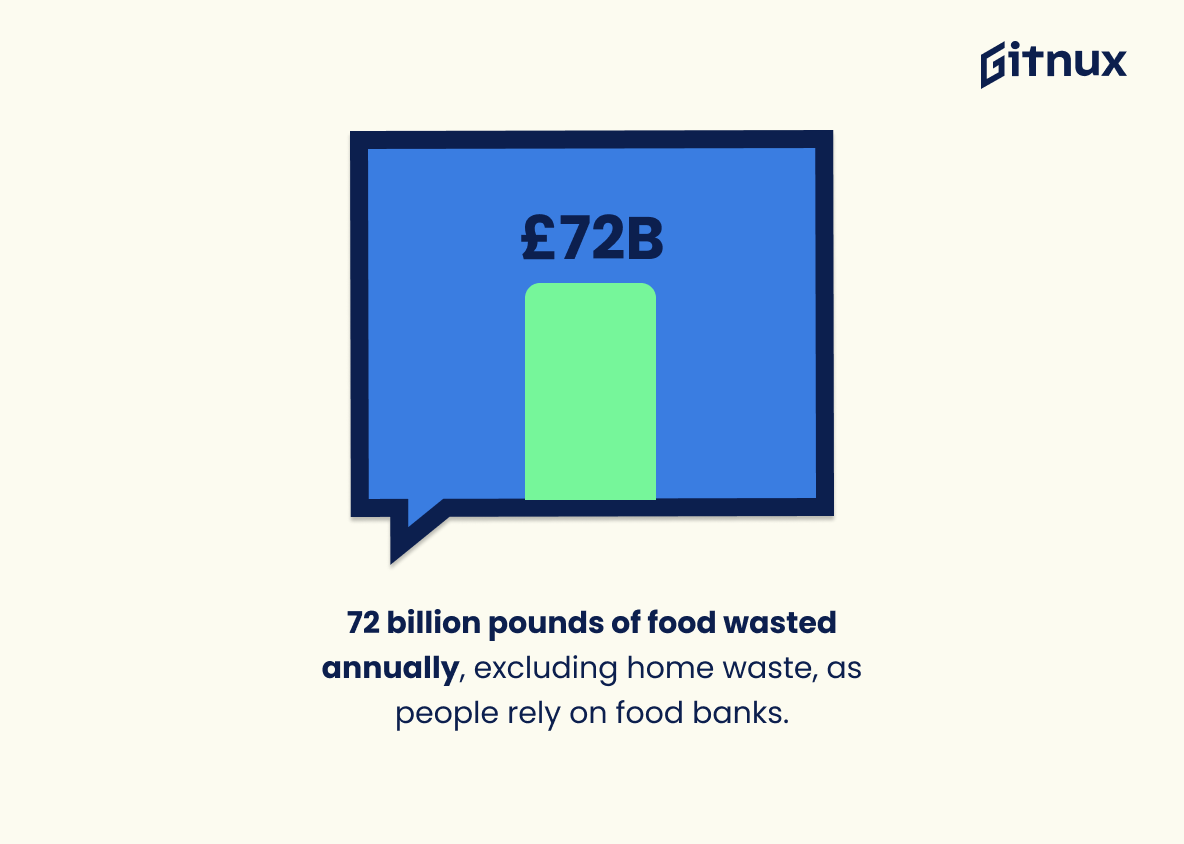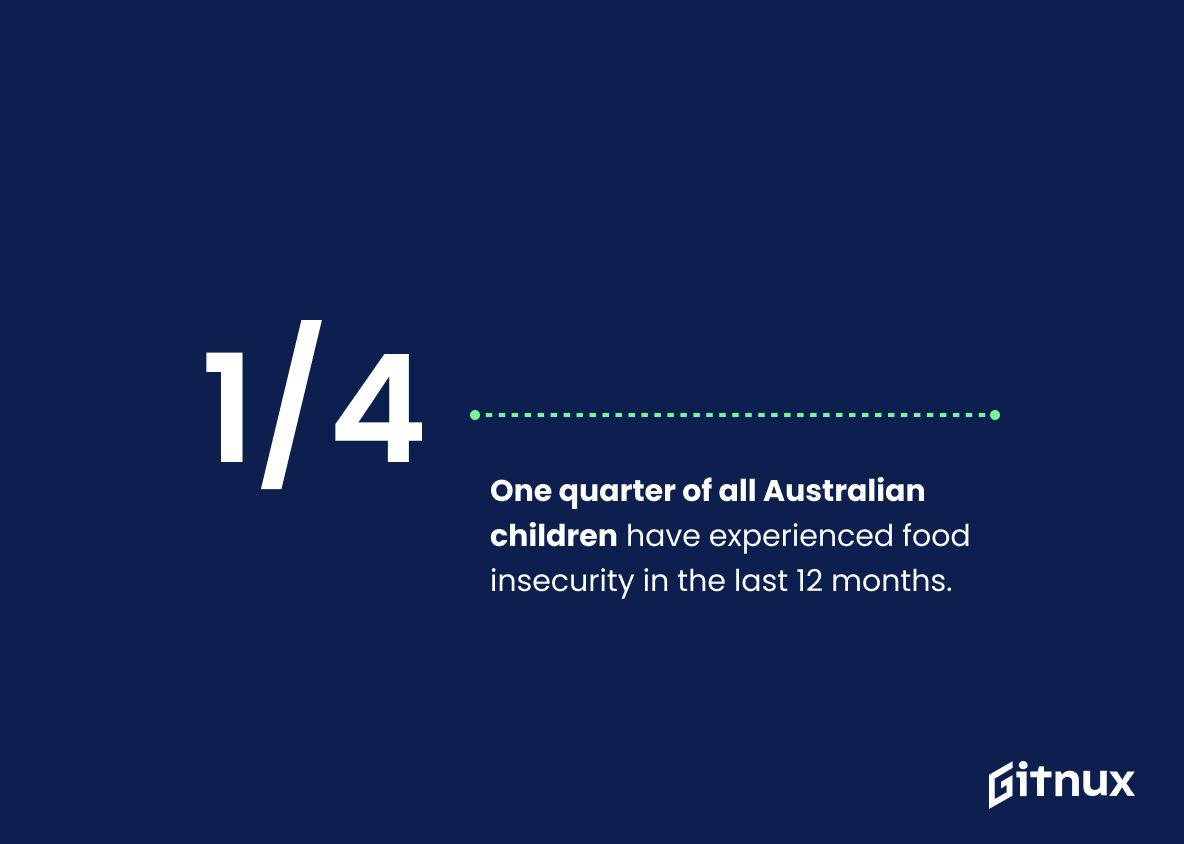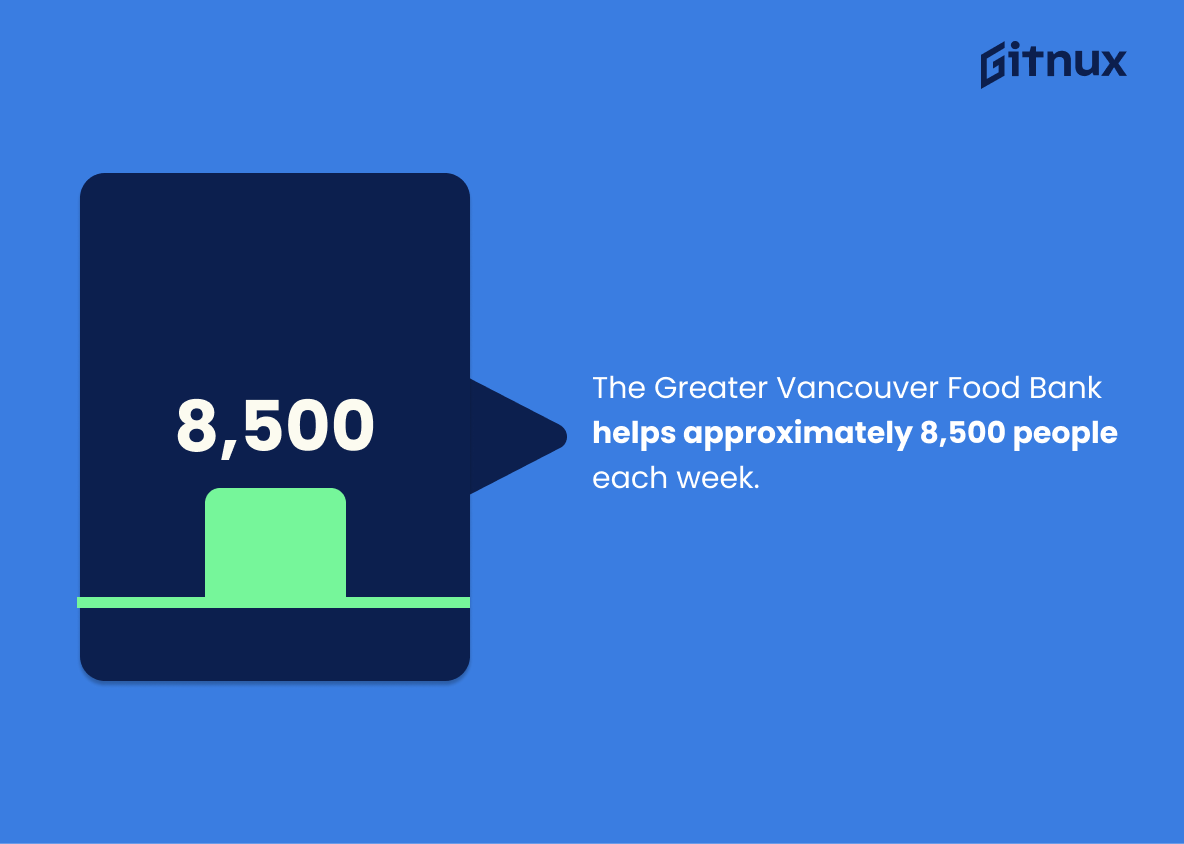In a world where millions have to suffer from the pangs of hunger, food banks have emerged as lifelines, providing sustenance to those in need. However, the crucial role and the far-reaching impact of these charities often go unnoticed. In this blog post, we delve deep into the heart of this issue, using infographics and numbers to bring you eye-opening food bank statistics.
Our aim is to not only shed light on the immense outreach of these organizations but also highlight the escalating need for more such initiatives. So, join us as we walk you through the factors that underline the importance of food banks in addressing global hunger.
The Latest Food Bank Statistics Unveiled
In the United States, 1 in 7 people rely on food banks – an estimated 46 million people.
Peering through the numerical lens, we discover the subtle inkling of an unsettling truth hidden within the heart of the United States – a staggering 1 in 7 of its inhabitants, roughly 46 million individuals, lean heavily on the crutch of food banks for sustenance. This disquieting revelation, nestled within the broader context of Food Bank Statistics, underscores a crucial, omnipresent issue that demarcates the contours between life’s haves and have-nots. It draws attention to the profound role that food banks play in bridging this chasm, serving as a testament to their invaluable importance in society.
Furthermore, it’s like uncovering the pulsating heartbeat of an unseen social epidemic, enlightening readers on the pervasive food insecurity that weaves itself into the fabric of everyday life for millions. Peeling back this layer illuminates the urgency to address malnutrition and food scarcity, advocating for public policies that eradicate hunger. This is more than a mere statistic, it’s an eye-opening narrative, profound enough to stir the winds of change.
37 million Americans (including 11 million children) face hunger every day.
In our world of plenty, it’s shocking to confront the startling figure: 37 million fellow Americans, among whom, 11 million are innocent children, battle hunger on a daily basis. As we dive into the realm of Food Bank statistics, this piece of data serves as a stark reminder of the urgent role that food banks play in our society.
Not just numbers on paper, but these figures echo the stomach-growling reality of Americans across the nation, underlining the crucial need to bolster our food bank system. Fitting all these pieces together, the puzzle of fighting hunger becomes clear – Food Banks are not just charitable corners, they are, indeed, lifelines for millions.
The number of food banks in the UK has increased from 29 in 2009 to over 2,000 in 2020.
To grasp the gravity of the escalating food insecurity in the UK, one must consider the astounding rise in food banks — a surge from a meager 29 in 2009 to more than 2,000 in 2020. This dramatic escalation isn’t merely a collection of cold, hard numbers, it mirrors a startling societal shift. It reflects not just the escalating demand for emergency food aid, but also serves as a stark reminder of the socio-economic challenges the nation has been grappling with.
By peering through this statistical lens, we gain critical insights into the often-unseen narratives behind the UK’s economic health and welfare policies, shedding light on pressing issues that could potentially envelop the nation if left unchecked. Undoubtedly, this drastic transformation of the food bank landscape is valuable in uncovering the intricacies of the UK’s fight against hunger and poverty.
Food banks in the UK gave out over 1.6 million food parcels to people in crisis in 2019.
In the vast kaleidoscope of life, statistics like “Food banks in the UK gave out over 1.6 million food parcels to people in crisis in 2019” act as a light, illuminating the dark corners of society often overlooked. In the narrative of a blog post centered on Food Bank Statistics, such a figure serves as a stark testament to the escalating issue of food poverty in a developed nation like the UK.
Drilling further down to specifics, every single one of the 1.6 million food parcels represents a person or family’s story of hardship and struggle, turning mere numbers into faces, hopes, and dreams. More than that, it presents an undeniable challenge to our collective conscience, provoking essential conversations about income inequality, economic policies, and social support systems.
This narrative, spun from a raw number, ensures the central message of any blog post about Food Bank statistics would resonate on a deeply human and emotive level, sparking not just intellectual understanding, but empathy, passion, and hopefully, action. Hence, the weight of 1.6 million moves the readers, inducing a call for change to address food poverty. It is a story told in numbers that vibrates with urgency.
More than 50 billion pounds of food end up in landfills while one third of food banks lack the donations they need.
In our exploration of Food Bank Statistics, let’s take a moment to consider a staggering reality. More than 50 billion pounds of food end up in landfills, an unfortunate wastefulness given the needs of many food banks. To juxtapose this wastage, a third of food banks are crying out for more food, their shelves lacking sufficient donations to fully meet the needs of those they serve.
Not only does this statistic highlight the tremendous imbalance between wastage and need, but it emphasizes an opportunity; the potential to bridge this gap. If the food currently doomed to decompose in landfills could instead reach food banks, we might see substantial changes in food bank provisions, and a subsequent decrease in hunger.
In Australia, 1 in 5 people have experienced food insecurity at least once in the last 12 months.
Highlighting the gravitas of the alarming figure that in Australia, every fifth person has encountered food insecurity within the span of a year, serves to instantaneously signal a crucial predicament in our societies. Delving into this statistic opens up a world of alarming nuances within the realms of food bank usage.
Through exploring this stark number, we uncover startling realities about the extensive dependency on food banks to fill this burgeoning gap, triggering conversations around sustainable solutions to ameliorate this substantial food insecurity concern.
Around 4 million people in Germany rely on food banks, a rise from 1.5 million in 2008.
Highlighting the stark rise in Germany’s reliance on food banks, from 1.5 million in 2008 to 4 million today, this figure captures a chilling narrative of increased food insecurity in one of Europe’s largest economies. This dramatic swell illuminates the escalating socio-economic challenges many are facing, painting a vivid portrait of hardship that compels readers to consider the pressing issues of food distribution, poverty alleviation, and social justice intensively debated across the nation.
Furthermore, it underscores the expanding role of food banks in filling the gaping chasm between an individual’s income and their nutritional needs, making it a critical data point for any discourse revolving around Food Bank Statistics.
The global food bank network serves 7.8 billion meals annually.
Feeding the taproot of comprehension, the statistic ‘The global food bank network serves 7.8 billion meals annually,’ plants a striking picture. To swiftly sail into the ocean of context in a blog post about Food Bank Statistics, envision each of these 7.8 billion meals as anchoring lifeboats.
They float into the turbulent seas of hunger and food insecurity, serving as lifelines for the nutritionally stranded across our global village. This magnitude of meal distribution not only underscores the scale of our collective efforts to combat hunger but also highlights the daunting expanse of need still calling for our resolve and action.
The COVID-19 pandemic in 2020 resulted in a 47% increase in the number of people relying on food banks in the United States.
To capture the enormity of the COVID-19 2020 pandemic’s impact on society, one doesn’t have to look further than the food banks. The statistic – a stark 47% surge in the number of people relying on food banks – illustrates a vivid picture of the pandemic’s ripple effects on the economy and the lives of ordinary citizens in the United States.
In the tapestry of food bank statistics, this 47% represents not merely a number, but millions of real stories – of job losses, of households struggling to make ends meet, and of the growing demand for basic food supplies. Amidst the bustle of pandemic statistics, this figure merits our attention, prompting us to contemplate on the unseen socio-economic consequences of the pandemic as it underscores the escalating need for food assistance across the nation.
It is estimated that 8.4 million people in the UK live in households that struggle to afford to buy enough food.
Delving into the profound depths of the UK’s food bank statistics, one can’t sidestep this staggering figure; a shocking 8.4 million UK residents are ensnared in the grip of food scarcity. As a chilling testament to the escalating food poverty crisis, this statistic underscores the critical role of food banks in providing a lifeline to these individuals.
The magnitude of this number, equivalent to roughly the entire population of London, paints a stark and compelling picture, creating a broad canvas on which to explore the contours of deprivation, inequality, and their entrenched links with food bank usage. This statistic is not merely an abstract number; it’s a grim real-world validation of the increasing dependency on food banks as a safety net against hunger.
In New York City, approximately 1.4 million residents rely on emergency food programs, including soup kitchens and food banks.
Drawing attention to the astounding fact that approximately 1.4 million residents of New York City depend on emergency food programs, such as soup kitchens and food banks, brings a powerful perspective to an analysis on Food Bank Statistics. It serves as a stark reminder of the sheer number of individuals grappling with hunger within the city’s confines.
As a reflection of the magnitude at which these critical services are necessary, this data point adds a tangible humanity to the conversation. It not only underscores the depth of the food insecurity problem but also highlights the scale at which food banks and similar initiatives are making a difference. Emphasizing this statistic aims to instigate a broader societal discussion and incite more strategic efforts to tackle food insecurity.
72 billion pounds of food go to waste each year, not including waste at home, while people continue to turn to food banks.
Painting a poignant picture, the staggering figure of 72 billion pounds of food squandered every year, not factoring in residential waste, starkly contrasts the escalating reliance on food banks. This unnerving paradox unravels a tale of immense food wastage on one hand, while hunger gnaws at millions on the other.
It underscores the need for transforming our food systems; to pivot from profligacy and towards better distribution. This efficiency could potentially make food banks more robust and eliminate the looming shadow of food insecurity. This statistic, therefore, forms a cornerstone in our conversation around food bank dynamics and the larger narrative of creating a world free from hunger.
One quarter of all Australian children have experienced food insecurity in the last 12 months.
Unpacking this striking statistic reveals the gravity of the issue at hand – it brings to light that one in every four Australian children has faced uncertainty when it comes to access to sufficient, nutritious food in the past year alone. The context here being a blog post about Food Bank Statistics, this statistic can serve as a beacon, shining a spotlight on the urgency and importance of the endeavors of food banks.
Paints a vivid picture, doesn’t it? A picture of where exactly the efforts of these food banks are directed. These organizations, therefore, serve as a critical lifeline, striving tirelessly to fill this void, boosting food security, and thus, directly impacting a staggering 25% of Aussie younglings’ lives.
The Greater Vancouver Food Bank helps approximately 8,500 people each week.
Using the veil of numbers, we shed light on the giant strides taken by the Greater Vancouver Food Bank, illuminating the magnitude of its impact. Each week, about 8,500 individuals, each with their own unique stories and struggles, find their pathways intersecting with this caring organization. This significant figure lends potency to the narrative by underscoring the critical role this food bank plays within the community. The statistic not only drives home the sheer scale of food insecurity but also amplifies the commendable efforts and reach of volunteer-driven initiatives in the fight against hunger.
Approximately 66% of the UK food banks reported an increase in demand during summer when children were out of school.
The statistic unearths an underappreciated facet of the summer holidays – a 66% surge in demand at UK food banks. This unexpected sunshine revelation reinforces the indisputable role these food banks play in bridging the meal gap for low-income families when school meals are not in session. Insightful as it is heartbreaking, this data spotlights the escalated struggle of one core section of society during the holiday season, thereby creating an impetus for increased support for food banks and a reevaluation of food strategies to assure no child goes hungry.
Food banks in France distribute around 100 million meals to those in need every year.
Reflecting upon this engaging nugget of information, we find ourselves venturing into the depths of poverty and the significant role of food banks. Painting a picture with numbers, it sheds light on the profound impact food banks have in France – a staggering 100 million meals annually are channeled to those grappling with food insecurity. This figure not only exemplifies the sheer magnitude of their job, but also underlines how crucial these establishments are as safety nets.
From a broader perspective, it compels us to question – if this is the case in one of the wealthiest countries, what would the scenario look like globally? Hence, this statistic forms a keyframe in our broader tableau of food bank operations, acting as a stark visual to emphasize the significance, necessity, and reach of these organizations.
Over 1.3 million individuals turned to Toronto’s Daily Bread Food Bank in 2020.
Highlighting the staggering figure of over 1.3 million individuals relying on Toronto’s Daily Bread Food Bank in 2020, illuminates the drastic scale of food insecurity in urban environments like Toronto. It serves as a significant indicator of not only the increased demand for food bank services but also hints towards broader socio-economic issues such as poverty, unemployment, and the impacts of a global pandemic.
In the canvas of Food Bank Statistics, this figure paints a vivid picture of the complex challenges our society faces in ensuring that every individual has access to basic necessities. Ultimately, by examining such powerful figures, readers are called to action, fostering discussions around food insecurity and measures to alleviate it.
Conclusion
In summary, food bank statistics reveal a profound issue that our society faces today – hunger and food insecurity. Although these numbers can seem disheartening, they also illuminate the tremendous efforts being made by food banks and volunteers to combat this issue. The importance of donations and volunteer work cannot be overstated. Each number represents a person, a family, or a child who is less worried about their next meal because of the invaluable work of food banks.
Hence, it is our collective responsibility to address this problem, whether it’s through policies, volunteering, or contributions. Awareness is just the first step; taking action is the key to make a significant difference. These statistics underscore the necessity and urgency for each one of us to contribute and make strides in ending hunger in our communities.
References
0. – https://www.www.feedingamerica.org
1. – https://www.www.foodbank.bc.ca
2. – https://www.www.banquealimentaire.org
3. – https://www.www.dailybread.ca
4. – https://www.www.trusselltrust.org
5. – https://www.feedingamerica.org
6. – https://www.www.dw.com
7. – https://www.www.foodbanking.org
8. – https://www.www.cityharvest.org
9. – https://www.www.foodbank.org.au
10. – https://www.www.foodaidnetwork.org.uk
11. – https://www.www.nrdc.org
